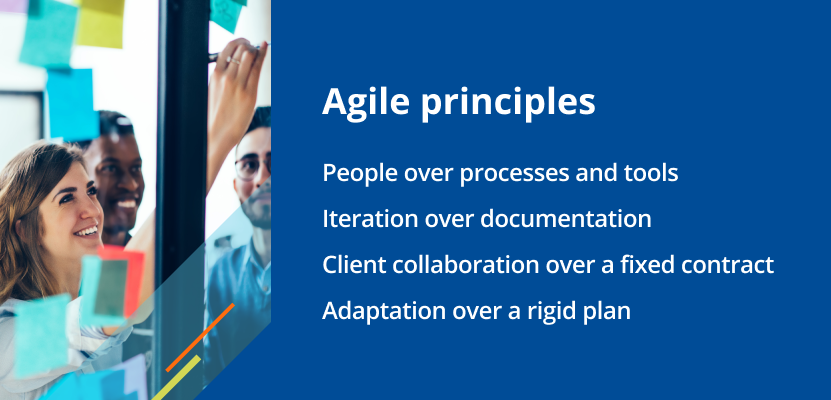
Agile methodology reorganizes the software development process in several key ways. Rather than a sequential, “Waterfall” approach to development where developers, testers, and business analysts work independently, Agile calls for intense collaboration between teams, and continuous communication with customers who are encouraged to provide feedback about the product throughout the development lifecycle.
Agile methodology also requires significant changes in the way software is tested. Rather than relegating software to the end of the development process, Agile software testing takes place at every stage of development. As a result, defects are found and fixed earlier in the process, helping to improve quality and reduce costs.
What is Agile methodology exactly?
Agile methodology is a set of principles more so than a distinct set of rules or guidelines. Agile practices are constantly evolving, and different organizations employ different versions of Agile development.
At its heart, Agile is about getting all the stakeholders involved in creating software to think differently about the development process. Agile encourages more effective collaboration to produce software with greater speed and higher quality, and to ensure that the customer receives a product that meets or exceeds their wishes.
The core values of Agile methodology include:
- A focus on people rather than processes and tools
- An iterative approach that values a working piece of software over detailed documentation
- An emphasis on ongoing collaboration with customers rather than the details of a fixed contract
- A need to adapt and respond to change rather than sticking to a detailed plan

The impact of Agile methodology on testing
Because Agile development incorporates many iterative phases rather than a single, sequential development process, traditional methods of software testing no longer apply. Where testing was once left until the very end of development, in Agile methodology it is integrated into the development lifecycle from day one. Instead of working independently from the development team, testers and quality assurance (QA) staff are integral members of the team who collaborate closely with developers, business analysts, and customers to review each iteration of the software and find bugs, defects, or problems with functionality that would adversely impact the user experience.
Because of the speed of software development, the Agile methodology requires automated testing tools that can significantly accelerate testing, improve accuracy, and enable testers to stay focused on high-value priorities rather than routine, mundane tasks. Agile testing also requires a certain amount of manual or exploratory testing. Test automation technologies can help teams manage the myriad of complex tasks involved in automated and manual testing for Agile development.
Common methods of Agile testing
Agile testing involves several methods that are designed to uncover defects early in the process and to ensure that the features and functionalities of software meet the customer’s requirements.
- Behavior-driven development (BDD) organizes testing priorities by starting with a scenario that clearly articulates for developers, testers, and business analysts how a specific feature of the software should function. Developers write code to support the scenario, testers create scripts to test the functionality, and business analysts compare the actual functionality to the customer’s wishes.
- Acceptance test-driven development (ATDD) encourages collaboration between developers, testers, and the customer to develop acceptance tests that evaluate the software as a user would in the real world. ATDD testing is driven by a user perspective, rather than a technical perspective.
- Exploratory testing is typically a manual test that relies on the creativity and critical thinking skills of testers to uncover actions or paths that break the software and reveal flaws. Rather than using pre-scripted tests, testers devise tests on the fly, with the result of one test informing the substance of the next.
- Session-based testing is a more orderly version of exploratory testing, designed to ensure that testing is comprehensive. Session-based testing adds charters that determine what should be tested and places emphasis on reporting to document what is discovered during each test.

The challenges of Agile testing – and how to resolve them
The Agile methodology places enormous pressure on testers. The speed of development is constantly changing and software must be continuously tested. Massive amounts of regression testing are required to ensure that new changes and additional functionality haven’t broken the software or impaired existing functionality. Though Agile sprints are short, each iteration requires extensive test coverage in a short period of time.
As the software becomes more complex with each iteration, more performance tests must be conducted to ensure that everything works to the user’s satisfaction and expectation. Any lag in performance testing can quickly create bottlenecks in the development process. API testing adds another layer of complexity, as virtually all modern software projects are expected to work equally well across different platforms.
The higher volume of tests involved in Agile development creates a greater burden of communication and organization for testers. Results must be delivered to the right stakeholders at the right time to enable production to continue at pace and to ensure that everyone has the information they need. Managing a myriad of tests, evaluating test coverage, and determining what additional tests to perform can easily overwhelm the QA staff.
Superior test automation technology can help address these challenges by automating a significant portion of the process, including regression testing, performance testing, and analysis of test coverage.
Agile testing with Tricentis
Tricentis provides software testing solutions that represent a fundamentally different approach to testing. Tricentis solutions are totally automated, fully codeless, and intelligently driven by AI. With Tricentis, Agile teams can dramatically accelerate software delivery, reduce costs, and improve quality.
Tricentis qTest is an Agile test management solution that enables teams to track, organize, and report against testing activities across the enterprise. With easy-to-use test management tools built for Agile methodology, Tricentis helps organizations prioritize quality, develop more reliable software, and increase speed to market. qTest offers a suite of tools that integrate testing with developer tools to enable continuous delivery by unifying and organizing testing efforts across the organization.

Tricentis Tosca is a next-generation automated continuous testing solution that enables teams to achieve unprecedented 90%+ test automation rates. Tricentis Tosca provides faster feedback for Agile and DevOps methodologies and reduces regression testing time to minutes. Testers can maximize reuse, minimize maintenance burden, and gain clear insight into business risk.
In addition to solutions for Agile testing, Tricentis provides tools for data integrity testing, performance testing, Jira test case management, smart impact analysis, Salesforce test automation, SAP tests, and more. Tricentis is an industry leader in AI-based automation testing, and Tricentis solutions are typically at the top of any test automation tools list.